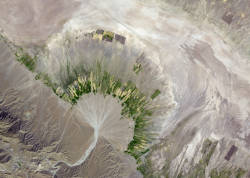Qanat


A Qanat or Kanat, (Persian قنات, Arabic قناة, DMG Qanāh) or also Kariz or Karez is a traditional form of fresh water extraction in desert areas. The names come from the Middle East because this form of water extraction is very widespread there. However, comparable systems are known all over the world, they are found in India, China, the Roman Empire and in Africa. The term has established itself beyond its origins as a technical term for this type of water extraction.
A qanat consists of horizontal ducts and vertical access shafts. As a rule, an aquifer is excavated in alluvium, i.e. less solidified clastic sediments. The water is channelled out of the mountain and used for irrigation or to fill a cistern. In addition, the tunnels often end in buildings, for example the mosque or a palace, and negative pressure is created via ventilation chimneys on the roof to draw cool air from the qanat. This works like an air conditioning system and cools the building.
In the Roman Empire, water supply was also based on canals, but aqueducts are of course much more spectacular than invisible canals. Tunnel sections are often called qanat, although this is actually incorrect. The construction of the tunnel with intermediate shafts is identical, but a qanat is exclusively underground.
 Gadara, Jordan
Gadara, Jordan Search DuckDuckGo for "Qanat"
Search DuckDuckGo for "Qanat" Qanat - Wikipedia (visited: 24-OCT-2020)
Qanat - Wikipedia (visited: 24-OCT-2020)
 Index
Index Topics
Topics Hierarchical
Hierarchical Countries
Countries Maps
Maps